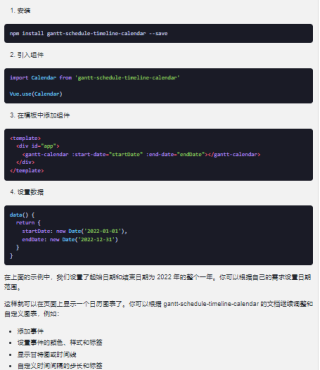vue3使用gantt-schedule-timeline-calendar教程
vue3使用gantt-schedule-timeline-calendar教程
回答引用chatGPT
1.首先,请确保你已经安装了 Vue3.x 和 "gantt-schedule-timeline-calendar" 组件,在项目中引入该组件:
npm install --save gantt-schedule-timeline-calendar
2.在模板中使用 "gantt-schedule-timeline-calendar" 组件,并传递必要的 props 属性:
<template>
<gantt-schedule-timeline-calendar
:items="items"
:groups="groups"
:default-date="defaultDate">
</gantt-schedule-timeline-calendar>
</template>
<script>
export default {
data() {
return {
items: [],
groups: [],
defaultDate: new Date(),
};
},
};
</script>
在这里,我们传递了三个必要的 props 属性: items,groups 和 default-date。
items 对象数组包含每个项目的详细信息,如 id、名称、开始和结束日期等。示例如下:
[
{
id: 1,
name: 'Project A',
start: new Date(2023, 5, 20),
end: new Date(2023, 5, 24),
},
{
id: 2,
name: 'Project B',
start: new Date(2023, 5, 21),
end: new Date(2023, 5, 25),
},
];
groups 对象数组包含不同的项目组,如部门、团队等。每个组有一个唯一的 ID 和名称。示例如下:
[
{
id: 1,
name: 'Department A',
},
{
id: 2,
name: 'Department B',
},
];
default-date 属性设置默认日期,如果没有设置它,则默认为当前日期。
以上是基本的使用步骤,请根据实际情况自定义和定制该组件。详细的文档和示例可以在 "gantt-schedule-timeline-calendar" 的 GitHub 页面中找到。
